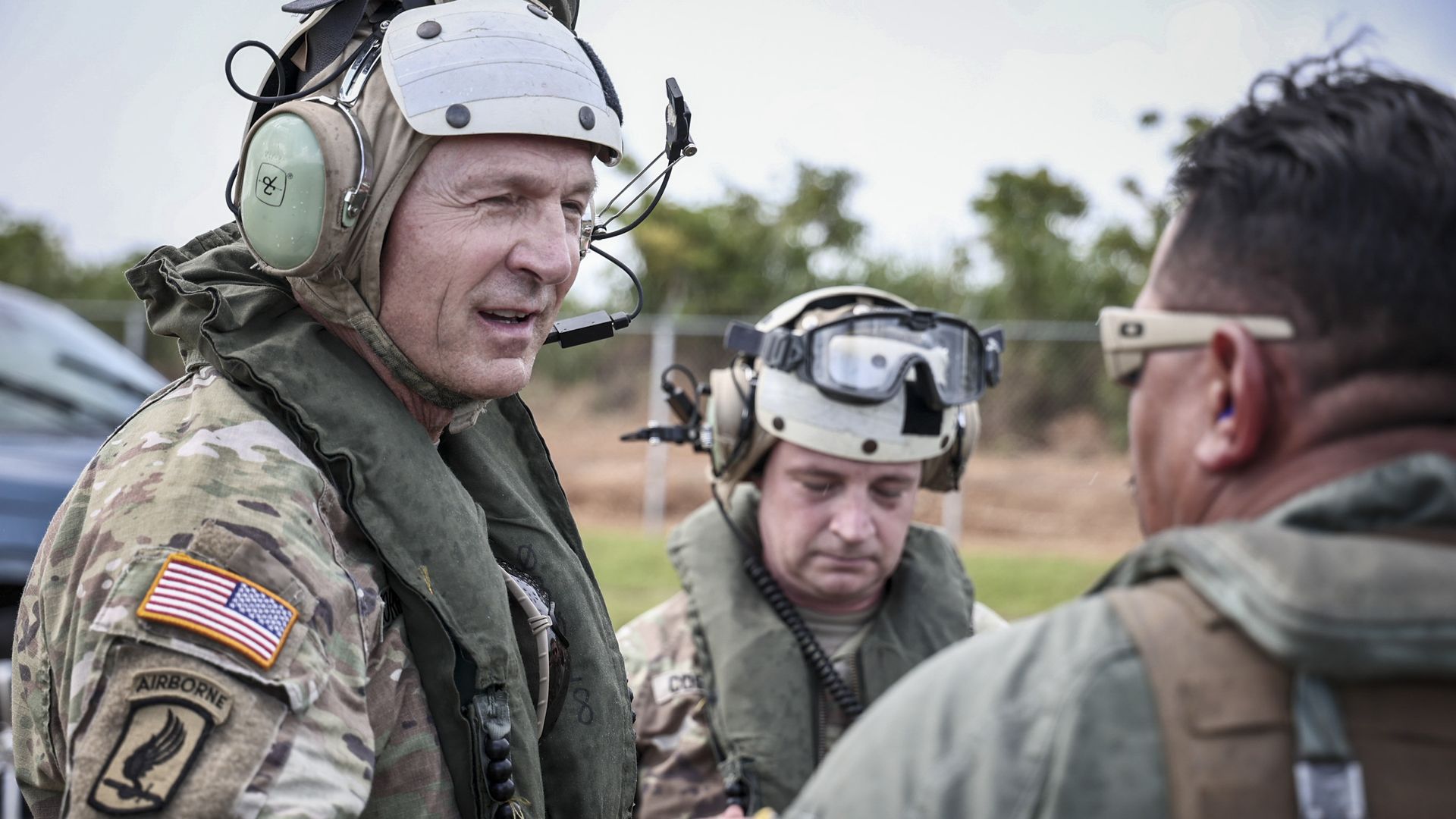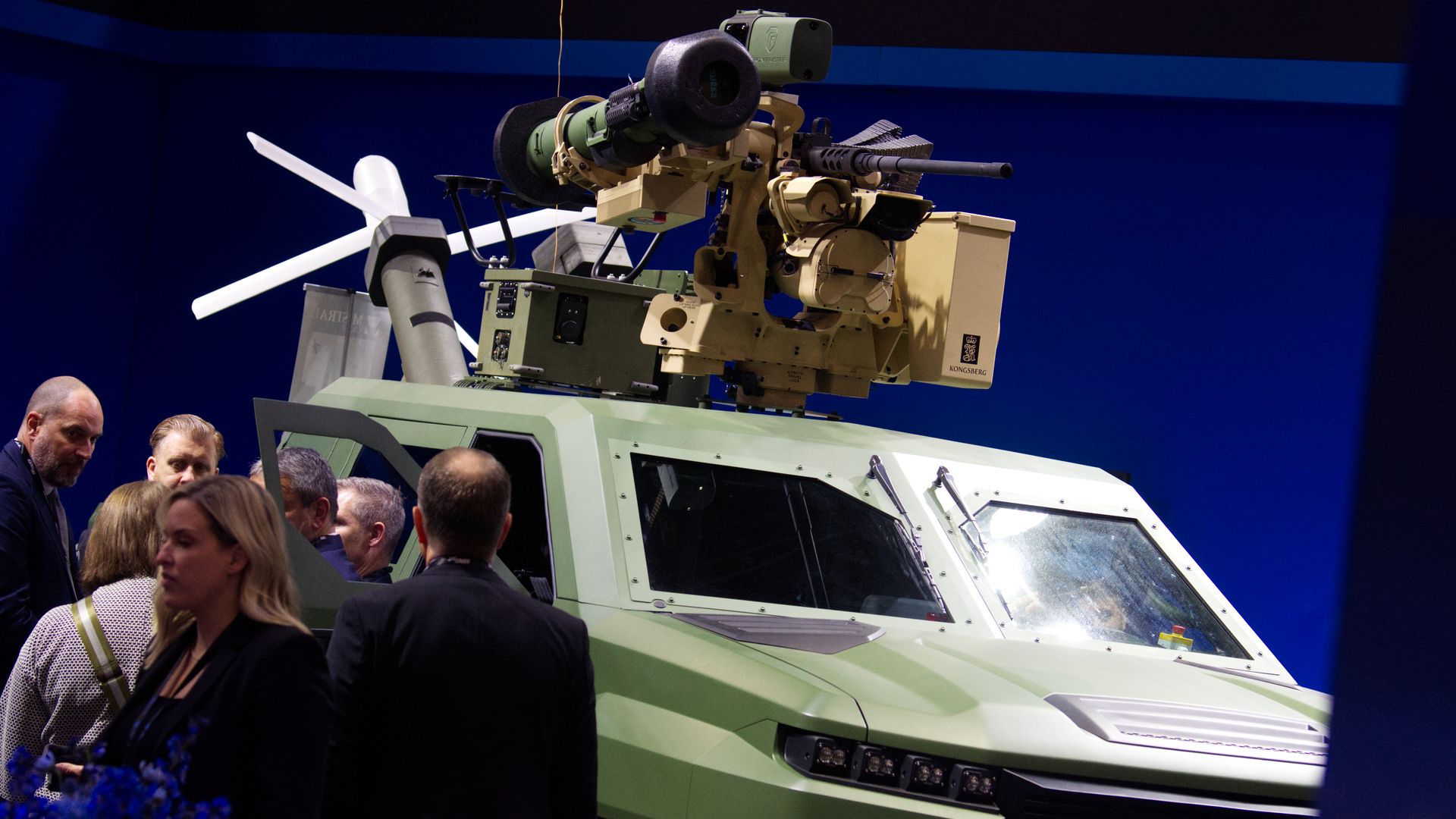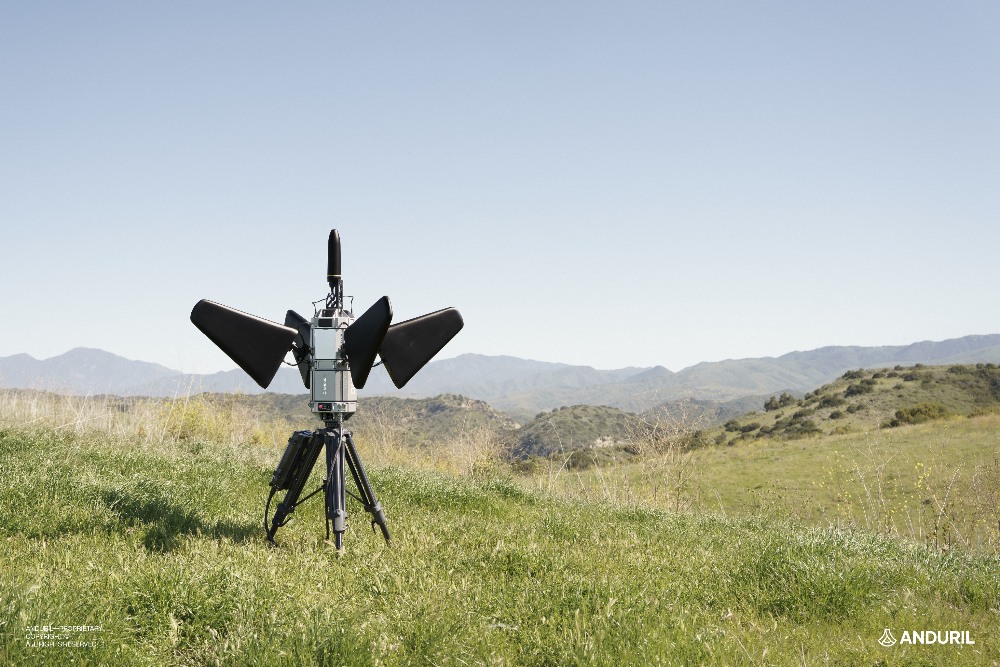| | | | | | | Presented By Anduril | | | | Axios Future of Defense | | By Colin Demarest · Oct 16, 2024 | | I'm back, just in time for the Association of the U.S. Army extravaganza. 🇮🇱 Situational awareness: The U.S. is sending to Israel a Terminal High Altitude Area Defense battery and troops to operate it, the Pentagon announced. - My thought bubble: This is a serious system the U.S. doesn't exactly have a lot of — and the move follows Israel burning through precious Arrow 2 and 3 interceptors.
The goods: AUSA sights and sounds and a chat with SAIC's Lauren Knausenberger. Today's newsletter is 1,530 words, a 6-minute read. | | | | | | 1 big thing: Gen. George's transformation | | |  | | | U.S. Army Gen. Randy George, left, readies for an aerial tour of Guam. Photo: Mark Scott/DVIDS | | | | My job is to write about the changing character of warfare. The U.S. Army chief of staff, Gen. Randy George, is trying to actually change it. Why it matters: For too long, things have taken too long, George told me in an interview in his Pentagon office, ahead of the land-power bonanza that is the annual Association of the U.S. Army conference. - The world, its wars and the weapons winning them are evolving at a blistering pace. Meanwhile, the U.S. military is largely at the mercy of trying-and-buying habits that make Blockbuster look newfangled.
- Places like the Defense Innovation Unit are touted for their flexibility but are system workarounds.
Driving the news: George months ago unveiled the "transforming in contact" initiative, meant to quickly arm soldiers and test commercially available kit the service thinks will define future warfare. - That effort is now mushrooming beyond its original units and focus areas, namely communications, jamming and spoofing, and drone warfare.
- Future experimentation will include two divisions, two armored brigade combat teams and two Stryker brigade combat teams.
- "What are war-winning capabilities? That's what we're focused on," George said. "We're going to have to make tough decisions on where do we not spend our money."
- The chief dubbed the expansion "2.0" in a speech at AUSA.
The intrigue: George is scheduled to sit on a panel today alongside Govini, Palantir Technologies and Anduril Industries executives. - That's not the Lockheed Martins of the world. Instead, it's the newer crop of contractors I previously wrote about.
- George told me he planned to meet this week with "a bunch of these companies that understand how to spin stuff quickly."
Zoom in: If transforming in contact is declared a success, it will be a tacit admission that Pentagon orthodoxy is broken. - It, too, is a sign of the times. Different gear is needed at different times in different regions for different fighting styles. And the U.S. is staring down a Russia-China double-barrel shotgun.
- "To actually do something different inside your formations, you have to change how you train and you operate," George said. "You have to change how you are organized, and you have to change how you buy things."
- "We're trying to get the mindset of the world is changing all the time," he added, "so we can't wait years to make change."
- Army Undersecretary Gabe Camarillo in an earlier interview told Axios the Army can't afford to "wait for a 10-year cycle for everyone to be uniform."
Friction point: Transforming in contact has taken blows from the old guard, according to George, who didn't name names. (Defense Department inertia is infamously stubborn.) But feedback on the ground, from troops who are working through the changes, has been positive. - "Bottom line, I'm biased," Col. James Stultz, with the 101st Airborne Division, told me in an email. "I think it's going well."
What's next: "We need to push ourselves to build a stronger culture of innovation inside the Army. We need to adopt a greater sense of urgency and accept greater risk," Army Secretary Christine Wormuth said in an AUSA speech. - "There is risk in testing new systems in challenging environments," she added. "But we do not have the luxury of time to wait for perfection."
Share this story |     | | | | | | 2. The AUSA weapons odyssey | | |  | | | GM Defense's Next-Generation Tactical Truck, kitted for war. Photo: Colin Demarest/Axios | | | | The Association of the U.S. Army blowout in the heart of the capital comes to an end today. - Here's what I heard, and what caught my eye.
The Rogue 1 drone was selected for the Organic Precision Fires-Light initiative. Photo: Colin Demarest/Axios Teledyne FLIR Defense mocked up a six-pack tube launcher for its Rogue 1 exploding drone. - Rogue 1 weighs about 10 pounds, and its quadcopter features fold out. The company planned to deliver more than 100 to the Marine Corps this year.
The AeroVironment P550 drone. Two Shryke munitions are slung below. Photo: Colin Demarest/Axios AeroVironment unveiled its P550, a drone that is easily reconfigured to carry lethal munitions, surveillance suites, electronic jammers and more. - "There is nothing in the market that we know of — we've done our homework — that has a combination of all these features and capabilities that this solution set provides," CEO Wahid Nawabi told reporters.
The Diamondback vehicle, parked at the L3Harris Technologies booth. Photo: Colin Demarest/Axios L3Harris Technologies rolled out a new autonomous vehicle, Diamondback. Overland AI is pitching in its off-road, cross-country navigation expertise. - The company is also on track to deliver more tactical software-defined radios to international customers than the Pentagon in the second half of this year, Samir Mehta, the president of communications systems, told me.
A Locust laser weapon can be seen atop a Stryker combat vehicle. Photo: Colin Demarest/Axios BlueHalo and Leonardo DRS perched a drone-zapping Stryker prototype on the show floor, shortly after successful testing in New Mexico. - The Locust laser weapon is the main draw here. It's stored inside the vehicle until needed and is complemented by other arms and an electronic warfare suite.
Mannequins man computers at the Israel Aerospace Industries booth. Photo: Colin Demarest/Axios Israel Aerospace Industries showed conference-goers footage of its Robotic Combat Task Force operating in Gaza. The task force's main purpose is to clear paths, flush out ambushes and neutralize IEDs. - The state-owned company also introduced Teaser, a guided missile that can be launched remotely or from the shoulder.
A small model of Grasshopper, a Dzyne-made cargo delivery aircraft. Photo: Colin Demarest/Axios Dzyne flaunted its Grasshopper glider, which autonomously delivers 500 pounds of ammo, water, food or whatever else after launching out the back of "anything that has a cargo door ramp," according to Matt McCue, the company's cofounder. - It first took flight in 2021, and has since been fielded. Each costs $40,000. McCue called that "extremely, extremely inexpensive."
A Lockheed Martin-made Sentinel A4 radar spins on the AUSA show floor. Photo: Colin Demarest/Axios Lockheed Martin's Sentinel A4 radars are currently being tested by the Army. The company expects to deliver a low-rate initial production batch beginning in late 2025. - Chandra Marshall, Lockheed's vice president for radar and sensor systems, told me there is immense interest in the system, which replaces the older RTX-made Sentinel A3.
The Kopin-made DarkWAVE, clipped onto night-vision goggles. Photo: Colin Demarest/Axios Electronics specialist Kopin showed me how its DarkWAVE night-vision goggle heads-up display works. - We cut the lights in a hotel room, and the attachment, seen above, fed me images and other info against the goggle's pallid-green illumination.
What's next: An AUSA postmortem coming soon. Promised. |     | | | | | | 3. Axios interview: Lauren Knausenberger | | |  | | | Lauren Knausenberger, at SAIC's corporate headquarters in Reston, Virginia. Photo: Colin Demarest/Axios | | | | This week's conversation is with Lauren Knausenberger, the executive vice president and chief innovation officer at SAIC. - We rendezvoused at SAIC's headquarters in Reston, Virginia, for this interview. I got stuck in Beltway traffic, of course. At least parking was easy.
Why she matters: Knausenberger previously served as the chief information officer at the Department of the Air Force, where she oversaw a portfolio totaling $17 billion. - She recently hit her one-year anniversary at SAIC.
Q: When you hear "future of defense," what comes to mind? A: Really, the general trend of moving more toward automated warfare, asymmetrical warfare, AI-based infiltration of networks and systems, and definitely autonomous systems. - Another thing that that comes to mind with future of defense is: I think our national defense strategy really has it right with "integrated deterrence."
Q: When will wars be waged solely by robots? A: Now, for the simple "can you use robots." But if we're talking about "solely waged," then probably we're talking end of days. If we're talking "solely," we've gone completely outside of human accountability. - I think and hope that, as humans, we will want to keep hold of what are our ideals and what are our objectives, and, at the very least, be giving strategic intent to robots that may fight more and more for us, but that we would continue to stay on top of the accountability and intent for what those robots are doing while waging the war.
Q: What's a national security trend we aren't paying enough attention to? A: A few on this one. - There's the rise of asymmetrical, AI-augmented warfare and a world where, increasingly, you have very cheap autonomous systems that can inflict major damage against billion-dollar platforms.
- The vulnerability of critical infrastructure. I think we've gotten lucky that we haven't had more major, catastrophic attacks — but you see things like Colonial Pipeline, vulnerabilities in power grids, any of those types of things.
- Finally, just the ability to drive hearts and minds using social media.
Q: What region of the world should we be watching? Why? A: Unfortunately, we are beyond the time when we have the luxury of looking at only one region of the world. Even if I just pick one competitor, let's say China, or even two, Russia, we can't just look at Ukraine or Taiwan. Q: How many emails do you get a day, and how do you deal with them? A: Too many. And not well. Q: What's a piece of gear or tech you can't go without? A: The less-traditional gadget that I have to share is my insta-hot water on my sink at home. - It's so easy for coffee or tea or oatmeal, or if I'm having people over for cocktails, I can whip up a simple syrup.
Q: What advice would you give your younger self? A: Just be you. It's going to be OK. - There's many other pieces of advice I could give my younger self, but I think it all ended up the way it was supposed to be.
|     | | | | | | A message from Anduril | | Anduril awarded air defense production contract with the DoD | | |  | | | | Anduril will deliver more than 500 Roadrunner-Ms and Pulsar EW systems. This state-of-the-art defense solution will counter the escalating threat of UAS attacks against U.S. forces and our allies. Rapid deployment begins this quarter. Learn more. | | | | | | 4. Check this out | | |  | | | I moderated a chat about U.S. Army networking with two of the service's leaders. Photo: Tasos Katopodis for AUSA | | | | Army Undersecretary Gabe Camarillo, Vice Chief of Staff Gen. James Mingus and I discussed all things connectivity, command posts and command and control at AUSA on Tuesday. Zoom in: The Pentagon's connect-everything-everywhere campaign, Combined Joint All-Domain Command and Control, is officially a "vibe," according to Camarillo. Missed it? No worries. Tune in here. |     | | | | | | A message from Anduril | | Anduril is rapidly scaling air defense solutions | | |  | | | | Since the public launch of its Roadrunner and Pulsar systems, Anduril has secured nearly $350 million in contracts, providing advanced air defense capabilities to multiple branches of the U.S. Department of Defense. Learn more. | | | | Shoutout to Nicholas Johnston for editing and Matt Piper for copy editing. Did I miss something? What did you like or dislike? Shoot me a message by replying to this email. |  | Your essential communications — to staff, clients and other stakeholders — can have the same style. Axios HQ, a powerful platform, will help you do it. | | | |

0 comentários:
Postar um comentário